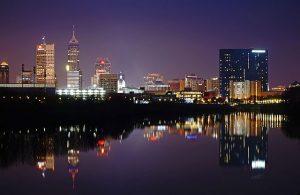
After just writing about how cities like Indianapolis, Columbus, and Raleigh had already won the HQ2 competition just by making the first cut, the New York Times adds further evidence in the form of a lengthy profile on Indianapolis.
[Salesforce Indianapolis CEO] Mr. Stutz lived in Austin, Tex. (another Amazon finalist), before moving to Seattle, and watched its evolution from sleepy state capital to technology hub and hip cultural magnet. “Austin was never a cool place,” he said. “Now it’s a hotbed of cool. Indianapolis isn’t quite there yet, but I see a lot of similarities.”
Last year Bon Appétit magazine devoted a feature to the “Brooklynization of Indy” that focused on the city’s explosion of craft breweries, artisanal bakeries and farm-to-table restaurants.
Transportation facilities are also prominent on Amazon’s wish list. The city’s light-filled new international airport has been voted the best in North America for five years running by Airports Council International and the best airport in the United States for four years by readers of Condé Nast Traveler.
The airport offers multiple direct flights to Seattle, San Francisco, New York, Boston and Washington, and is about to start nonstop service to Paris.
Indianapolis’s central location and network of interstate highways earned the city its nickname, the Crossroads of America. Amazon is among the large companies with distribution centers there.
While Indianapolis lacks subways, light rail or a sophisticated urban transport network, the city is crisscrossed with bike and walking trails. Mr. Stutz said many Salesforce employees biked or walked to work (something Amazon’s Seattle employees value).
It’s hard to ask for better press than that. The fact that the article notes some of the city’s warts actually makes the piece more credible than a typical travel section style feature (e.g., 36 Hours in X). This is a home run for Indy in terms of earned media.
The NYT mentions that Salesforce has been a booster of Indy’s Amazon bid. That’s smart for them. If Indy did get HQ2, it would make it much more competitive for Salesforce to recruit to say the least. So Salesforce probably doesn’t think Indy stands a realistic shot. But they do realize that anything that raises the brand profile of Indianapolis is a big boost for their own recruiting efforts there. Smart thinking.
Of course it is possible that Indy or another city could get some Amazon presence even without the HQ2. Joe Cortright makes this very argument, in which he says Amazon will likely pick three or four cities for various HQ2 functions, so that it can continue to play them off against each other. I did not go this far in my thinking, but I do think it’s possible that a city (or multiple cities) that’s a loser in the HQ2 battle might conceivably end up with some kind of smaller Amazon office.
While there are real benefits like this NYT profile to making the Amazon cut, I don’t think cities that didn’t make it should beat themselves up too much. We really don’t know the factors that went into deciding who was in and who was out. Some of the people who are in may have been put there for pure misdirection for all we know. Maybe even Indianapolis. And being left off the list may not be reflective of the city as a whole. Cleveland, for example, has many problems, but is also one of the few place with an actual HQ2 scale entity locally in the Cleveland Clinic. In that health care space, Cleveland has proven it can attract the best talent in the world at scale. That’s just not relevant to Amazon. So while those who did make the list should feel good about it, I don’t think those who didn’t should wallow in undue negativity. As the New York Times notes, even the “losers” are potentially in line for future Amazon investments.
This piece originally appeared on Urbanophile.
Aaron M. Renn is a senior fellow at the Manhattan Institute, a contributing editor of City Journal, and an economic development columnist for Governing magazine. He focuses on ways to help America’s cities thrive in an ever more complex, competitive, globalized, and diverse twenty-first century. During Renn’s 15-year career in management and technology consulting, he was a partner at Accenture and held several technology strategy roles and directed multimillion-dollar global technology implementations. He has contributed to The Guardian, Forbes.com, and numerous other publications. Renn holds a B.S. from Indiana University, where he coauthored an early social-networking platform in 1991.
Photo Credit: Miyin2 CC BY-SA 4.0












